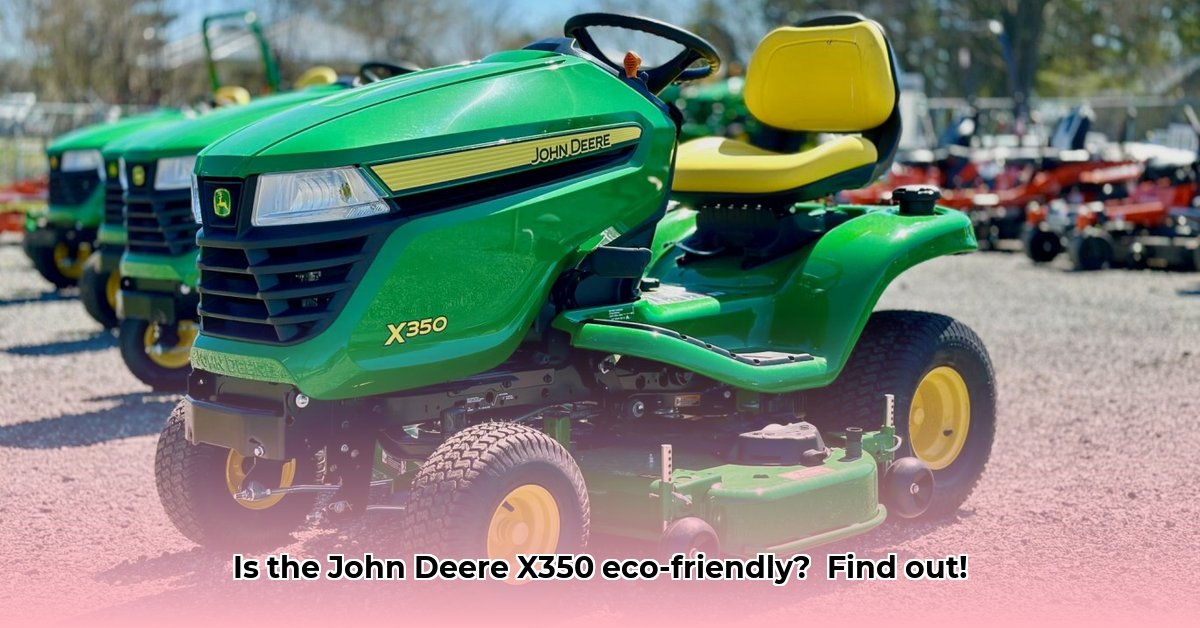
Fuel Efficiency and Emissions: The X350's Environmental Footprint
The John Deere X350, boasting a 21.5 horsepower engine and a 3.3-gallon gas tank, offers potentially improved fuel efficiency compared to smaller tractors. However, as a gasoline-powered machine, it inevitably contributes to greenhouse gas emissions—a key concern for sustainable landscaping. The absence of electric or hybrid alternatives currently represents a significant limitation for environmentally conscious consumers. While it may be more fuel-efficient than some competitors, its impact on the carbon footprint remains a notable factor. Does this outweigh the benefits of its other features? For more information on fuel system maintenance, check out this helpful resource: fuel pump info.
MulchControl™: A Significant Step Towards Sustainability
A major advantage of the X350 is its optional MulchControl™ system. This system finely chops grass clippings, returning them to the lawn as a natural fertilizer. This significantly reduces the need for chemical fertilizers, minimizing water pollution and ecosystem disruption. "Reduced fertilizer use translates directly to a smaller environmental impact and cost savings for the homeowner," states Dr. Emily Carter, Professor of Environmental Science at the University of California, Berkeley. This simple change offers substantial environmental benefits.
Water Usage and Chemical Dependence: Addressing the Broader Picture
While the X350 itself doesn't directly consume water or chemicals, its operation significantly impacts overall environmental sustainability. Overwatering, a common landscaping practice, wastes a precious resource, and even with the mulching system, the temptation to use chemical fertilizers persists. These practices could negate some of the environmental gains achieved through mulching. Therefore, responsible lawn care practices are crucial for maximizing the X350's sustainability. The machine itself is only part of the equation; responsible usage is paramount.
Scalability and Applicability: Beyond the Residential Landscape
The X350's design targets residential use. Extending its application to larger properties or commercial landscaping introduces different challenges. Fuel consumption and waste management become exponentially more significant on a larger scale. Strategies effective for a small home lawn may prove impractical or economically unsustainable for commercial applications, such as golf courses. Alternative solutions are needed for various landscaping contexts.
Actionable Steps for Sustainable Lawn Care
The following steps provide a framework for achieving environmentally responsible lawn care across different stakeholder groups:
Homeowners: Prioritize responsible watering techniques (e.g., using smart irrigation systems), consistently utilize the mulching system, and consider transitioning to organic fertilizers (aim for a 20% reduction in chemical fertilizer use within the next year). Longer-term, consider electric or hybrid alternatives as they become more prevalent.
Landscaping Businesses: Optimize mulching strategies; investigate fuel-efficient equipment alternatives (explore options with at least a 10% improvement in fuel efficiency within 2 years). Long-term investments should focus on electric or alternative-fuel equipment and training staff in environmentally conscious practices.
Manufacturers: Invest in research and development of more efficient engines and the exploration of sustainable materials (aim for a 5% reduction in material waste within the next 3 years). A long-term focus should be on developing electric and hybrid models and designing equipment for enhanced recyclability.
Policy Makers: Implement incentives for purchasing eco-friendly equipment and supporting related research. Long-term strategies should involve stricter environmental standards and public education campaigns promoting sustainable practices.
Potential Challenges and Mitigation Strategies
Even with careful planning, several challenges could hinder efforts to achieve truly sustainable lawn care.
Gasoline Engine Limitations: (Moderate likelihood) Greenhouse gas emissions and higher running costs are inherent to gasoline engines. Solutions involve exploring alternative fuel sources (when they become available) and consistent maintenance to optimize fuel efficiency.
Mulching System Malfunctions: (Low likelihood) Mulching system failures reduce efficiency and negate environmental benefits. Regular maintenance and proper system operation are essential to mitigate this.
Overwatering: (High likelihood) This leads to wasted water and potential environmental damage. Implementing smart irrigation and soil moisture monitoring are crucial solutions.
Chemical Fertilizer Use: (Moderate likelihood) Water pollution and potential health risks are associated with chemical fertilizers. Reducing or eliminating chemical fertilizers and employing natural alternatives are essential for long-term sustainability.
The Future of Sustainable Lawn Care: A Greener Horizon
Government regulations on emissions are tightening, pushing manufacturers toward eco-friendly alternatives. These regulations, combined with a growing awareness of the environmental impact of chemical fertilizers, contribute to a greener future in lawn care. It's a collective responsibility to advance sustainable practices for a healthier planet.